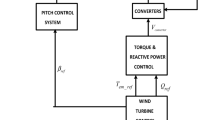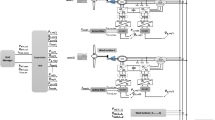Abstract
Fault ride through (FRT) capability creates a challenging condition for wind turbines (WTs) with a doubly fed induction generator (DFIG). In order to fulfill the FRT requirement for WTs with DFIG, the over-current in rotor circuit and theDC-link over-voltage during fault conditions must be addressed. This paper proposes an application of the model predictive control (MPC) system to power converters and uses Takagi–Sugeno–Kang type fuzzy logic control for improving the FRT capability of WTs with DFIG. The effectiveness of the proposed MPC method is compared with conventional proportional-plus-integral controllers with pulse-width modulation. The real-time simulation results illustrate the improved performance offered by the proposed control scheme for maintaining the rotor current and the DC-link voltage within permissible ranges when power grid faults occur.















Similar content being viewed by others
References
Saravanakumar, R., Jena, D.: Validation of an integral sliding mode control for optimal control of a three bladed variable speed variable pitch wind turbine. Int. J. Electron. Power Energy Syst. 69(4), 421–429 (2015)
Saravanakumar, R., Jena, D.: Nonlinear control of wind turbine with optimal power capture and load mitigation. Energy Syst. 7(3), 429–448 (2016)
Asgari, S., Yazdizadeh, A.: Robust model-based fault diagnosis of mechanical drive train in V47/660 kW wind turbine. Energy Syst. (2017). doi:10.1007/s12667-017-0231-2
Thomas, A.: Wind Power in Power Systems. Wiley, New York (2005)
Ghoudelbourk, S., Dib, D., Omeiri, A.: Decoupled control of active and reactive power of a wind turbine based on DFIG and matrix converter. Energy Syst. 7(3), 483–497 (2016)
Semen, S., Niiranen, J., Kanerva, S., Arkkio, A., Saitz, J.: Performance study of a doubly fed wind-power induction generator under network disturbance. IEEE Trans. Energy Convers. 21(4), 883–890 (2006)
Pannell, G., Atkinson, D.J., Zahawi, B.: Minimum-threshold crowbar for a fault-ride-through grid-code-compliant DFIG wind turbine. IEEE Trans. Energy Convers. 25(3), 750–759 (2010)
Vidal, J., Abad, G., Arza, J., Aurtenechea, S.: Single-phase DC crowbar topologies for low voltage ride through fulfillment of high-power doubly fed induction generator-based wind turbines. IEEE Trans. Energy Convers. 28(3), 768–781 (2013)
Tsili, M., Papathanassiou, S.: A review of grid code technical requirements for wind farms. IET Renew. Power Gener. 3(3), 308–332 (2009)
Qiao, W., Venayagamoorthy, G.K., Harley, R.G.: Real-time implementation of a STATCOM on a wind farm equipped with doubly fed induction generators. IEEE Trans. Ind. Appl. 45(1), 98–107 (2009)
Rahim, A.H.M.A., Nowicki, E.P.: Supercapacitor energy system for fault-ride through of a DFIG wind generation system. Energy Convers. Manag. 52, 96–102 (2012)
Zhang, S., Tseng, K.J., Choi, S.S., Nguyen, T.D., Yao, D.L.: Advanced control of series voltage compensation to enhance wind turbine ride through. IEEE Trans. Power Electron. 27(2), 763–772 (2012)
Huchel, L., El Moursi, M.S., Zeineldin, H.H.: A parallel capacitor control strategy for enhanced FRT capability of DFIG. IEEE Trans. Sustain. Energy 6(2), 303–312 (2015)
Guo, W., et al.: Overview and development progress of a 1-MVA/1-MJ superconducting fault current limiter-magnetic energy storage system. IEEE Trans. Appl. Superconduct. 26(3), 1–5 (2016)
Chen, L., et al.: Coordinated control of SFCL and SMES for transient performance improvement of microgrid with multiple DG units. Can. J. Electr. Comput. Eng. 39(2), 158–167 (2016)
Karaipoom, T., Ngamroo, I.: Optimal superconducting coil integrated into DFIG wind turbine for fault ride through capability enhancement and output power fluctuation suppression. IEEE Trans. Sustain. Energy 6(1), 28–42 (2015)
Huang, P.H., Mouri, M.S.E., Hasen, S.A.: Novel fault ride through scheme and control strategy for doubly fed induction generator-based wind turbine. IEEE Trans. Energy Convers. 30(2), 635–645 (2015)
da Costa, J.P., Pinheiro, H., Degner, T., Arnold, G.: Robust controller for DFIGs of grid-connected wind turbines. IEEE Trans. Ind. Electron. 58(9), 4023–4038 (2011)
Hossain, M.J., Saha, T.K., Mithulannanthan, N., Pota, H.R.: Control strategies for augmenting LVRT capability of DFIGs in interconnected power system. IEEE Trans. Ind. Electron. 60(6), 2510–2522 (2013)
Xiao, S., Yang, G., Zhou, H.L., Geng, H.: An LVRT control strategy based on flux linkage tracking for DFIG-based WECS. IEEE Trans. Ind. Electron. 60(7), 2820–2832 (2013)
Xie, D., Xu, Z., Yang, L., Stergaard, J., Xue, Y., Wong, K.P.: A comprehensive LVRT control strategy for DFIG wind turbines with enhanced reactive power support. IEEE Trans. Power Syst. 28(3), 3302–3310 (2013)
Rahimi, M., Parniani, M.: Transient performance improvement of wind turbines with doubly fed induction generators using nonlinear control strategy. IEEE Trans. Energy Convers. 25(2), 514–525 (2010)
Liang, J., Qiao, W., Harley, R.G.: Feed-forward transient current control for low-voltage ride-through enhancement of DFIG wind turbines. IEEE Trans. Energy Convers. 25(3), 836–843 (2010)
Liang, J., Howard, D.F., Restrepo, J.A., Harley, R.G.: Feed-forward transient compensation control for DFIG wind turbines during both balanced and unbalanced grid disturbances. IEEE Trans. Ind. Appl. 49(3), 1452–1463 (2013)
Mokryani, G., Siano, P., Piccolo, A., Chen, Z.: Improving fault ride-through capability of variable speed wind turbines in distribution networks. IEEE Syst. J. 7(4), 713–722 (2013)
Vrionis, T.D., Koutiva, X.I., Vovos, N.A.: A genetic algorithm-based low voltage ride-through control strategy for grid connected doubly fed induction wind generators. IEEE Trans. Power Syst. 29(3), 1325–1334 (2014)
Morshed, M.J., Fekih, A.: Integral terminal sliding mode control to provide fault ride-through capability for a grid connected wind turbine driven DFIG. Proc. IEEE Int. Conf. Ind. Technol. 2015, 1059–1064 (2015)
Rahimi, M., Parniani, M.: Coordinated control approaches for low-voltage ride-through enhancement in wind turbines with doubly fed induction generators. IEEE Trans. Energy Convers. 25(3), 873–883 (2010)
Kouro, S., Cortes, P., Vargas, R., Ammann, U., Rodriguez, J.: Model predictive control—a simple and powerful method to control power converters. IEEE Trans. Ind. Electron. 56(6), 1826–1838 (2009)
Rodriguez, J., Cortes, P.: Predictive Control of Power Converters and Electrical Drives. Wiley, New York (2012)
Singh, B., Kyriakides, E., Singh, S.N.: Intelligent control of grid connected unified doubly-fed induction generator. IEEE Power Energy Soc. Gen. Meet. 2010, 1–7 (2010)
Yang, L., Xu, Z., Ostergaard, J., Dong, Z.Y., Wong, K.P.: Advanced control strategy of DFIG wind turbines for power system fault ride through. IEEE Trans. Power Syst. 27(2), 713–722 (2012)
MathWorks, Simulink Real-Time; Getting Started Guide. The Math-Works, Inc (2014)
Kasem, A.H., EI-Saadany, E.F., EI-Tamaly, H.H., Wahab, M.A.A.: An improved fault ride-through strategy for doubly fed induction generator-based wind turbines. IET Renew. Power Gener. 2(4), 201–214 (2008)
Patel, C.K., Lee, H.T., KrooI, M.: XXIX OSTIV Congress. Extracting energy from atmospheric turbulence. Lüsse, Berlin (2008)
Author information
Authors and Affiliations
Corresponding author
Rights and permissions
About this article
Cite this article
Taher, S.A., Arani, Z.D., Rahimi, M. et al. Model predictive fuzzy control for enhancing FRT capability of DFIG-based WT in real-time simulation environment. Energy Syst 9, 899–919 (2018). https://doi.org/10.1007/s12667-017-0252-x
Received:
Accepted:
Published:
Issue Date:
DOI: https://doi.org/10.1007/s12667-017-0252-x




